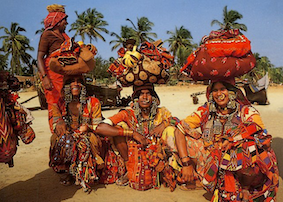The Colour Wheel
- kalash

- Jun 9, 2020
- 2 min read
Updated: May 2, 2021

The easiest way for me to think about what colours to choose is to think natural pigments because that is what people had access to prior to manufactured dyes.
I am very fortunate to have travelled extensively, staying with many different tribal peoples, learning about their traditions and crafts. Almost 40 years ago in Guatemala I watched the Mayan men and women preparing the cotton threads for their back strap looms by winding the warp threads around telegraph poles (the perfect distance apparently). The thread was painstakingly dyed and overdyed using plant dyes which creates their unique ikat/jaspe fabrics, the method dating back centuries.
Each woman would weave her own strongly coloured huipile (a top) using a back strap loom, in the same style as her mother and grandmother, which would then be heavily embroidered. Each village we visited would have its own distinct colouring and pattern design. This reminds me of traditions closer to home with the intricate knitting patterns of the Aran and Guernsey fisherman's jumper where the different stitches depict things from their everyday lives.
On a more recent visit to Guatemala it was interesting to see how chemical dyes have crept in producing some pretty lurid combinations with fluorescent pink being a favourite. Initially I was horrified to see these outlandish colours and saddened by the use of sewing machines for the embroidery, but of course it absolutely makes sense because it is labour saving and although fluorescent pink wouldn't be my choice of colour somehow these bright colours do work.
My personal preference is for the more natural pigments which for me reflect the tribal peoples I have spent time with over the last 40 years so I'm sort of stuck in that pre-chemical dye period - so rusts and burnt oranges, reds and burgundies, ochre and earth and of course black.
In my aesthetic I tend to avoid the jewel colours so popular with many troupes - jade, lapis lazuli, turquoise, emerald, amethyst. These colder colours, the blues, greens and purples are much more difficult to achieve the look I want to create, although not impossible. Colour combining one of these jewel colours with one of the earthy warm pigment colours can sometimes do the trick - light green and a warm rich brown or a warm burgundy with lapis blue, introducing a different tone of one of the colours or even another warm earthy colour in a hip scarf can help pull everything together and this is where the colour wheel is very helpful.
There can sometimes be a tendency to colour co-ordinate everything - matching flowers, make-up, choli and pantaloons with maybe a contrasting skirt colour which can sometimes end up looking like a uniform. So if you’re looking for inspiration it is really helpful to look at pictures of tribal women to see how they put things together. It is much more eclectic because they only have the materials and dyes they have to hand. They will often wear completely mis-matched patterns and colours but there is always something about their attire which bonds them as a tribe or family and shows where they're from or who they feel they belong to.
It's definitely worth experimenting









Comments